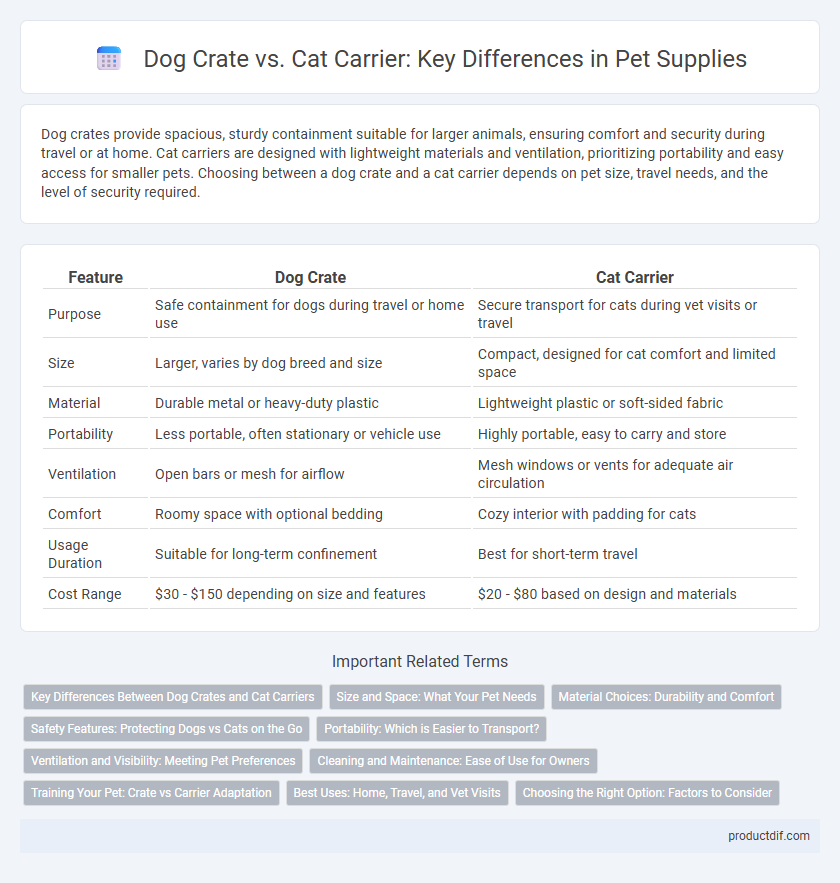Dog crates provide spacious, sturdy containment suitable for larger animals, ensuring comfort and security during travel or at home. Cat carriers are designed with lightweight materials and ventilation, prioritizing portability and easy access for smaller pets. Choosing between a dog crate and a cat carrier depends on pet size, travel needs, and the level of security required.
Table of Comparison
| Feature | Dog Crate | Cat Carrier |
|---|---|---|
| Purpose | Safe containment for dogs during travel or home use | Secure transport for cats during vet visits or travel |
| Size | Larger, varies by dog breed and size | Compact, designed for cat comfort and limited space |
| Material | Durable metal or heavy-duty plastic | Lightweight plastic or soft-sided fabric |
| Portability | Less portable, often stationary or vehicle use | Highly portable, easy to carry and store |
| Ventilation | Open bars or mesh for airflow | Mesh windows or vents for adequate air circulation |
| Comfort | Roomy space with optional bedding | Cozy interior with padding for cats |
| Usage Duration | Suitable for long-term confinement | Best for short-term travel |
| Cost Range | $30 - $150 depending on size and features | $20 - $80 based on design and materials |
Key Differences Between Dog Crates and Cat Carriers
Dog crates are typically larger, sturdier, and designed for extended confinement, featuring durable materials and ventilation suitable for a dog's size and activity level. Cat carriers prioritize portability, lightweight construction, and easy access, often including soft-sided options and secure closures for stress-free travel. Key differences focus on size, durability, ventilation, and convenience tailored to the distinct behaviors and needs of dogs versus cats.
Size and Space: What Your Pet Needs
Dog crates typically offer more spacious interiors to accommodate larger breeds and allow comfortable movement, while cat carriers are designed to be compact yet cozy, prioritizing security over space. Selecting the right size ensures your dog can stand, turn, and lie down easily, whereas cats benefit from snug, enclosed spaces that reduce stress during travel. Measuring your pet accurately and considering their specific comfort needs prevents anxiety and promotes safety in both crates and carriers.
Material Choices: Durability and Comfort
Dog crates often feature heavy-duty materials like reinforced steel and high-grade plastic to ensure durability and support larger breeds, while cat carriers prioritize lightweight, breathable fabrics or hard plastic for ease of transport and ventilation. Padded interiors with soft cushioning are common in cat carriers to enhance comfort during travel, whereas dog crates may include removable mats or liners tailored for sturdiness and easy cleaning. Choosing materials that balance durability with comfort is essential for both to meet the specific needs of dogs and cats during confinement or transport.
Safety Features: Protecting Dogs vs Cats on the Go
Dog crates often feature reinforced metal frames and secure locking mechanisms to ensure maximum protection during travel, preventing escape and injury. Cat carriers prioritize soft, padded interiors with ample ventilation and escape-proof zippers to reduce stress and maintain safety. Both designs incorporate safety harness attachments and durable materials tailored to their species-specific needs, enhancing on-the-go protection.
Portability: Which is Easier to Transport?
Dog crates are typically larger and heavier, making them less portable compared to cat carriers, which are designed to be lightweight and compact for easy transport. Cat carriers often feature handles and shoulder straps, enhancing convenience for short trips and vet visits. For pet owners prioritizing portability, cat carriers offer a more practical solution due to their smaller size and easier maneuverability.
Ventilation and Visibility: Meeting Pet Preferences
Dog crates typically offer larger ventilation panels and more open wire designs, ensuring maximum airflow and visibility for pets who enjoy observing their surroundings. Cat carriers often feature smaller mesh windows or ventilation slots tailored to cats' preference for cozy, secure environments while still allowing adequate airflow. Both designs prioritize optimal ventilation and visibility to meet the distinct comfort and behavioral needs of dogs and cats during travel.
Cleaning and Maintenance: Ease of Use for Owners
Dog crates typically feature removable trays and large doors, allowing easy access for thorough cleaning and quick maintenance. Cat carriers are often smaller with less space inside, making spot cleaning more frequent but full cleanings slightly more tedious due to confined spaces. Both options benefit from materials like plastic and metal that are durable and resistant to odors, simplifying long-term upkeep for pet owners.
Training Your Pet: Crate vs Carrier Adaptation
Dog crates provide a structured environment that helps with house training and behavioral correction by promoting a den-like space, whereas cat carriers offer a confined, transport-focused area ideal for short-term containment rather than extended training. Dogs benefit from crate training through consistent positive reinforcement, leading to improved discipline and security during solo periods. Cats adapt better to carriers when gradually introduced, but their training is more about acclimatization to travel than behavioral modification.
Best Uses: Home, Travel, and Vet Visits
Dog crates provide ample space and ventilation, making them ideal for home confinement and long car trips where comfort and security are paramount. Cat carriers are typically lightweight and compact, perfect for quick vet visits and short travel durations where ease of handling is crucial. Selecting the right containment solution depends on pet size, travel frequency, and specific use cases such as extended stays or rapid transportation.
Choosing the Right Option: Factors to Consider
When selecting between a dog crate and a cat carrier, consider the pet's size, temperament, and travel frequency to ensure comfort and safety. Dog crates typically offer more space and ventilation for larger breeds and extended confinement, while cat carriers prioritize portability and secure enclosure for short trips. Material durability, ease of cleaning, and compliance with airline regulations are critical factors influencing the choice for both dogs and cats.
Dog crate vs Cat carrier Infographic

 productdif.com
productdif.com